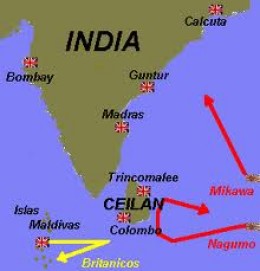
Much has been written about the Imperial navy of Japan and the C in C of the fleet Admiral Yamamoto. However though, the Japanese Navy was an extremely professional force, it was apt to fritter its energy in unproductive operations. One such operation was launched in the Indian Ocean at the behest of Yamamoto. This was after the great success of the attack on Pearl Harbor. The attack served no purpose and was devoid of any strategic plan and Yamamoto comes out as a man who had little sense of strategic operations. One of the Principles of War namely conservation of effort was disregarded and now forms an important aspect of the Staff course at DSSC.
The Japanese fleet after decimating the American fleet at Pearl Harbor under Admiral Chuichi Nagumo returned to Japan and received a hero's welcome. After a few days the Imperial fleet sailed to the Celebes and was anchored there. This was the time Admiral Yamamoto decided on a 'domination' exercise in the Indian Ocean and bombardment of Ceylon. The exercise itself served no purpose and in effect the Japanese admiralty missed a golden opportunity to invade India from the south after occupying Ceylon. At that time the British strength was at its nadir and Ceylon and South India had hardly any troops. In effect it could have been a cake walk for the Japanese army and Navy.
Admiral Nagumo was again appointed the commander of the fleet and orders were passed to him to proceed and attack Ceylon. No marines were assigned to the fleet as Yamamoto had no plans other than a show of force, which in hindsight looks pointless. The fleet consisting of 6 aircraft carriers and associated warships sailed out from its base at Staring bay on 26 march 1942. the fleet also had 4 battleships and 19 destroyers and was a very formidable force. This formidable Naval armada was invincible and the British just did not have the means to stop it.
The fleet sailed into the Bay of Bengal and as per plan one squadron led by Admiral Ozawa broke way and headed towards the Andaman islands. The British were taken aback and 23 merchant vessels were sunk by the fleet. Nagumo continued with the main fleet and reached the southern tip of Ceylon at Galle. He ordered an aerial bombardment of military installations at Galle. There was no resistance as the British never in their wildest dreams thought the Japanese would attack Ceylon. Admiral Nagumo continued further and neared Colombo on 5 April 1942. Air attacks again commenced on the port and barracks. Many ships were sunk and a scared British expecting an invasion of Ceylon instructed their ships on the high sea to escape to East Africa. Two destroyers trying to escape to East Africa were detected by the Japanese and sunk and 400 lives were lost. Nagumo was master of all that he surveyed. Unfortunately he had no marines and Naguma signaled his disappointment to the Admiralty. He thus could not launch a land invasion. It was a strategic error of immense proportion. Only if Naguma had troops he could have started an invasion of Ceylon and then enter India from the South as the all the British had in entire South India was one division and no aircraft.
On 6th April, Nagumo received a coded message to return and reluctantly he had to disengage and head back. This was because of the plan of Yamamoto to destroy the US carrier fleet at Midway. In effect from the military point of view the operation in the Indian Ocean without a strategic plan was a pointless exercise and achieved nothing. One wonders if the Japanese had a division or two with them at that time they could have easily overrun Ceylon and launched an invasion of India from the South. It would have changed the dynamics of world history.
Map of Imperial Navy domination exercise from Wiki free commons